+ Open data
Open data
- Basic information
Basic information
| Entry | Database: PDB / ID: 7jup | ||||||
|---|---|---|---|---|---|---|---|
| Title | Structure of human TRPA1 in complex with antagonist compound 21 | ||||||
 Components Components | Transient receptor potential cation channel subfamily A member 1 | ||||||
 Keywords Keywords |  MEMBRANE PROTEIN/Antagonist / MEMBRANE PROTEIN/Antagonist /  TRPA1 / channel / TRPA1 / channel /  agonist / agonist /  MEMBRANE PROTEIN / MEMBRANE PROTEIN /  MEMBRANE PROTEIN-Antagonist complex MEMBRANE PROTEIN-Antagonist complex | ||||||
| Function / homology |  Function and homology information Function and homology informationtemperature-gated cation channel activity / stereocilium bundle / detection of chemical stimulus involved in sensory perception of pain /  thermoception / thermoception /  TRP channels / channel activity / response to pain / cellular response to organic substance / intracellularly gated calcium channel activity / detection of mechanical stimulus involved in sensory perception of pain ...temperature-gated cation channel activity / stereocilium bundle / detection of chemical stimulus involved in sensory perception of pain / TRP channels / channel activity / response to pain / cellular response to organic substance / intracellularly gated calcium channel activity / detection of mechanical stimulus involved in sensory perception of pain ...temperature-gated cation channel activity / stereocilium bundle / detection of chemical stimulus involved in sensory perception of pain /  thermoception / thermoception /  TRP channels / channel activity / response to pain / cellular response to organic substance / intracellularly gated calcium channel activity / detection of mechanical stimulus involved in sensory perception of pain / monoatomic ion transport / sensory perception of pain / response to cold / response to organic substance / calcium ion transmembrane transport / TRP channels / channel activity / response to pain / cellular response to organic substance / intracellularly gated calcium channel activity / detection of mechanical stimulus involved in sensory perception of pain / monoatomic ion transport / sensory perception of pain / response to cold / response to organic substance / calcium ion transmembrane transport /  calcium channel activity / intracellular calcium ion homeostasis / response to organic cyclic compound / cellular response to hydrogen peroxide / protein homotetramerization / cell surface receptor signaling pathway / response to xenobiotic stimulus / identical protein binding / calcium channel activity / intracellular calcium ion homeostasis / response to organic cyclic compound / cellular response to hydrogen peroxide / protein homotetramerization / cell surface receptor signaling pathway / response to xenobiotic stimulus / identical protein binding /  plasma membrane plasma membraneSimilarity search - Function | ||||||
| Biological species |   Homo sapiens (human) Homo sapiens (human) | ||||||
| Method |  ELECTRON MICROSCOPY / ELECTRON MICROSCOPY /  single particle reconstruction / single particle reconstruction /  cryo EM / Resolution: 3.05 Å cryo EM / Resolution: 3.05 Å | ||||||
 Authors Authors | Rohou, A. / Rouge, L. | ||||||
 Citation Citation |  Journal: J Med Chem / Year: 2021 Journal: J Med Chem / Year: 2021Title: Tetrahydrofuran-Based Transient Receptor Potential Ankyrin 1 (TRPA1) Antagonists: Ligand-Based Discovery, Activity in a Rodent Asthma Model, and Mechanism-of-Action via Cryogenic Electron Microscopy. Authors: Jack A Terrett / Huifen Chen / Daniel G Shore / Elisia Villemure / Robin Larouche-Gauthier / Martin Déry / Francis Beaumier / Léa Constantineau-Forget / Chantal Grand-Maître / Luce ...Authors: Jack A Terrett / Huifen Chen / Daniel G Shore / Elisia Villemure / Robin Larouche-Gauthier / Martin Déry / Francis Beaumier / Léa Constantineau-Forget / Chantal Grand-Maître / Luce Lépissier / Stéphane Ciblat / Claudio Sturino / Yong Chen / Baihua Hu / Aijun Lu / Yunli Wang / Andrew P Cridland / Stuart I Ward / David H Hackos / Rebecca M Reese / Shannon D Shields / Jun Chen / Alessia Balestrini / Lorena Riol-Blanco / Wyne P Lee / John Liu / Eric Suto / Xiumin Wu / Juan Zhang / Justin Q Ly / Hank La / Kevin Johnson / Matt Baumgardner / Kang-Jye Chou / Alexis Rohou / Lionel Rougé / Brian S Safina / Steven Magnuson / Matthew Volgraf /     Abstract: Transient receptor potential ankyrin 1 (TRPA1) is a nonselective calcium-permeable ion channel highly expressed in the primary sensory neurons functioning as a polymodal sensor for exogenous and ...Transient receptor potential ankyrin 1 (TRPA1) is a nonselective calcium-permeable ion channel highly expressed in the primary sensory neurons functioning as a polymodal sensor for exogenous and endogenous stimuli and has generated widespread interest as a target for inhibition due to its implication in neuropathic pain and respiratory disease. Herein, we describe the optimization of a series of potent, selective, and orally bioavailable TRPA1 small molecule antagonists, leading to the discovery of a novel tetrahydrofuran-based linker. Given the balance of physicochemical properties and strong target engagement in a rat AITC-induced pain assay, compound was progressed into a guinea pig ovalbumin asthma model where it exhibited significant dose-dependent reduction of inflammatory response. Furthermore, the structure of the TRPA1 channel bound to compound was determined via cryogenic electron microscopy to a resolution of 3 Å, revealing the binding site and mechanism of action for this class of antagonists. | ||||||
| History |
|
- Structure visualization
Structure visualization
| Movie |
 Movie viewer Movie viewer |
|---|---|
| Structure viewer | Molecule:  Molmil Molmil Jmol/JSmol Jmol/JSmol |
- Downloads & links
Downloads & links
- Download
Download
| PDBx/mmCIF format |  7jup.cif.gz 7jup.cif.gz | 740.1 KB | Display |  PDBx/mmCIF format PDBx/mmCIF format |
|---|---|---|---|---|
| PDB format |  pdb7jup.ent.gz pdb7jup.ent.gz | 621.4 KB | Display |  PDB format PDB format |
| PDBx/mmJSON format |  7jup.json.gz 7jup.json.gz | Tree view |  PDBx/mmJSON format PDBx/mmJSON format | |
| Others |  Other downloads Other downloads |
-Validation report
| Arichive directory |  https://data.pdbj.org/pub/pdb/validation_reports/ju/7jup https://data.pdbj.org/pub/pdb/validation_reports/ju/7jup ftp://data.pdbj.org/pub/pdb/validation_reports/ju/7jup ftp://data.pdbj.org/pub/pdb/validation_reports/ju/7jup | HTTPS FTP |
|---|
-Related structure data
| Related structure data |  22490MC M: map data used to model this data C: citing same article ( |
|---|---|
| Similar structure data |
- Links
Links
- Assembly
Assembly
| Deposited unit | 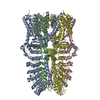
|
|---|---|
| 1 |
|
- Components
Components
| #1: Protein | Mass: 72622.125 Da / Num. of mol.: 4 Source method: isolated from a genetically manipulated source Source: (gene. exp.)   Homo sapiens (human) / Gene: TRPA1, ANKTM1 / Production host: Homo sapiens (human) / Gene: TRPA1, ANKTM1 / Production host:   Spodoptera frugiperda (fall armyworm) / References: UniProt: O75762 Spodoptera frugiperda (fall armyworm) / References: UniProt: O75762#2: Chemical | ChemComp-VKM / Has ligand of interest | Y | |
|---|
-Experimental details
-Experiment
| Experiment | Method:  ELECTRON MICROSCOPY ELECTRON MICROSCOPY |
|---|---|
| EM experiment | Aggregation state: PARTICLE / 3D reconstruction method:  single particle reconstruction single particle reconstruction |
- Sample preparation
Sample preparation
| Component | Name: TRPA1 bound by antagonist compound 21 / Type: COMPLEX / Entity ID: #1 / Source: RECOMBINANT | ||||||||||||||||||||
|---|---|---|---|---|---|---|---|---|---|---|---|---|---|---|---|---|---|---|---|---|---|
| Molecular weight | Units: MEGADALTONS / Experimental value: NO | ||||||||||||||||||||
| Source (natural) | Organism:   Homo sapiens (human) Homo sapiens (human) | ||||||||||||||||||||
| Source (recombinant) | Organism:   Spodoptera frugiperda (fall armyworm) Spodoptera frugiperda (fall armyworm) | ||||||||||||||||||||
| Buffer solution | pH: 8.2 | ||||||||||||||||||||
| Buffer component |
| ||||||||||||||||||||
| Specimen | Conc.: 0.33 mg/ml / Embedding applied: NO / Shadowing applied: NO / Staining applied : NO / Vitrification applied : NO / Vitrification applied : YES : YES | ||||||||||||||||||||
| Specimen support | Details: Solarus plasma cleaner / Grid material: GOLD / Grid mesh size: 300 divisions/in. / Grid type: UltrAuFoil R2/2 | ||||||||||||||||||||
Vitrification | Instrument: FEI VITROBOT MARK IV / Cryogen name: ETHANE / Humidity: 100 % / Chamber temperature: 277 K Details: Triple blot. Put blot in vitroblot Apply 3.5ul to grid, wait 30sec, blot manually Apply 3.5ul to grid, wait 30sec, blot manually, apply final 3.5ul, final blot by vitrobot (3.5s) |
- Electron microscopy imaging
Electron microscopy imaging
| Experimental equipment |  Model: Titan Krios / Image courtesy: FEI Company |
|---|---|
| Microscopy | Model: FEI TITAN KRIOS |
| Electron gun | Electron source : :  FIELD EMISSION GUN / Accelerating voltage: 300 kV / Illumination mode: FLOOD BEAM FIELD EMISSION GUN / Accelerating voltage: 300 kV / Illumination mode: FLOOD BEAM |
| Electron lens | Mode: BRIGHT FIELD Bright-field microscopy / Nominal magnification: 165000 X / Cs Bright-field microscopy / Nominal magnification: 165000 X / Cs : 2.7 mm / C2 aperture diameter: 70 µm / Alignment procedure: COMA FREE : 2.7 mm / C2 aperture diameter: 70 µm / Alignment procedure: COMA FREE |
| Specimen holder | Cryogen: NITROGEN / Specimen holder model: FEI TITAN KRIOS AUTOGRID HOLDER |
| Image recording | Average exposure time: 1.6 sec. / Electron dose: 41.8 e/Å2 / Detector mode: COUNTING / Film or detector model: GATAN K2 QUANTUM (4k x 4k) / Num. of grids imaged: 1 / Num. of real images: 8915 |
| EM imaging optics | Energyfilter name : GIF Bioquantum / Energyfilter slit width: 20 eV : GIF Bioquantum / Energyfilter slit width: 20 eV |
| Image scans | Sampling size: 5 µm / Movie frames/image: 40 / Used frames/image: 1-40 |
- Processing
Processing
| EM software |
| |||||||||||||||||||||||||||||||||||||||||||||||||||||||||||||||||
|---|---|---|---|---|---|---|---|---|---|---|---|---|---|---|---|---|---|---|---|---|---|---|---|---|---|---|---|---|---|---|---|---|---|---|---|---|---|---|---|---|---|---|---|---|---|---|---|---|---|---|---|---|---|---|---|---|---|---|---|---|---|---|---|---|---|---|
CTF correction | Type: PHASE FLIPPING AND AMPLITUDE CORRECTION | |||||||||||||||||||||||||||||||||||||||||||||||||||||||||||||||||
| Particle selection | Num. of particles selected: 395169 | |||||||||||||||||||||||||||||||||||||||||||||||||||||||||||||||||
| Symmetry | Point symmetry : C4 (4 fold cyclic : C4 (4 fold cyclic ) ) | |||||||||||||||||||||||||||||||||||||||||||||||||||||||||||||||||
3D reconstruction | Resolution: 3.05 Å / Resolution method: FSC 0.143 CUT-OFF / Num. of particles: 101265 / Algorithm: FOURIER SPACE / Details: No data beyond 4.4 A were used during refinement. / Num. of class averages: 1 / Symmetry type: POINT | |||||||||||||||||||||||||||||||||||||||||||||||||||||||||||||||||
| Atomic model building | Protocol: FLEXIBLE FIT / Space: REAL | |||||||||||||||||||||||||||||||||||||||||||||||||||||||||||||||||
| Atomic model building | PDB-ID: 6X2J Accession code: 6X2J / Source name: PDB / Type: experimental model |
 Movie
Movie Controller
Controller



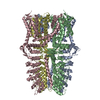


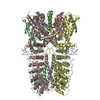
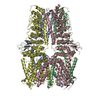

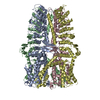
 PDBj
PDBj




